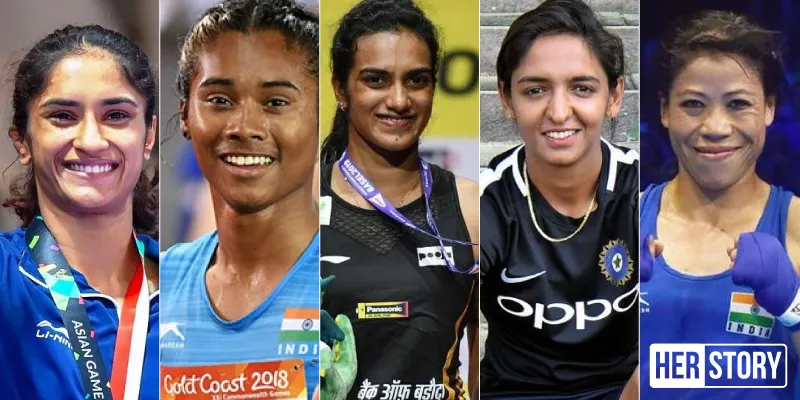To create more Sindhus, Himas and Dutees, India needs to develop women’s sports at the grassroot level
Indian women are slaying it on the international arena. Sportswomen in athletics, badminton, and table tennis have kept the Indian flag flying high. Encouraging girls into sports at a young age, and giving them a healthy foundation and infrastructure is key to their future success.
The entire nation watched in awe as champion shuttler PV Sindhu became India’s first world champion in badminton when she beat Japan’s Nozomi Okuhara in the women’s singles finals of the BWF World Championships held in Basel last week.

So far, Sindhu has won five medals at the World Championships and after the defining moment, she said, “I felt on top of the world.”
Just like Sindhu, Indian sportswomen have been making their mark across the world this year. It has been raining gold - from Hima Das and Dutee Chand in track and field, shooter Rahi Das, Divya Karan and Vinesh Phogat in wrestling, Mirabai Chanu in weightlifting to Ayhika Mukherjee and Manika Batra in table tennis and Harmanpreet Kaur in cricket.
Most recently, the Indian women’s hockey team won an Olympic test event against Japan 2-1. Also, 17-year-old Komalika Bari became the third Indian to win the world archery champion crown beating the higher ranked Sonoda Waka of Japan at the 2019 World Archery Youth Championships in Madrid.
Girls are finding their place in the international sports arena, and flying the Indian flag higher. Now is the time to hone talents in all sports.
In the Interim Budget presented by then Finance Minister Piyush Goyal in February 2019, Rs 214.2 crore was allocated to the Sports and Youth Affairs Ministry. The allocation was increased to Rs 450 crore in the budget presented by Finance Minister Nirmala Sitharaman in July, with an added fillip of widening the Khelo India Programme by announcing the setting up of a National Sports Education Board (NSEB).
With the government’s emphatic thumbs up to sports in India, can this augur the golden period for Indian women in sports in India?
Women are being empowered to break barriers and making a positive difference. Now, the onus lies in creating a conducive environment for women in diverse sports to get the support they need to flourish.
Unwavering spirit
1567057300659.png?fm=png&auto=format)
Swapna Burman with her Asian Games gold
Swapna Burman, who became the first heptathlete to win a gold at the Asian Games last year, became a champion despite having two extra toes, and many other challenges.
The athlete tells HerStory, “I come from a very modest family where financial struggles were constant and training wasn’t easily accessible. But despite these difficulties, I have never stopped dreaming. On the field, it isn’t about where you are from, what you do or how long it has taken you. It’s about the grit you show. Most importantly, I had the support of my family who believed in my dreams and never stopped me from pursuing sports as a career. I have all the support I need now, and I will utilise it, and hope for the best possible outcome.”
She adds, “Two extra toes meant an increased chance of injury, and that’s just one of the things to be careful about while training. I have always believed that it is mind over body. This belief has instilled in me the courage to overcome challenges.”
It’s this indomitable spirit that has carried the women through. Look at PU Chitra, for instance, who hails from Munrad village in Palakkad district (Kerala), whose her parents are daily wage earners. Like many other sportswomen from small towns in India, Chitra did not have any gear and access to resources. Despite the odds, she won gold in the 1,500 m event in at Doha and was dubbed ‘Queen of Asia in the mile’. Many other athletes like Dutee Chand, PR Poovamma, and Annu Rani fall into the small town, big dreams category, and have proved their mettle despite humungous obstacles.
Alpine skier Mishael Kanwal says, “Indian sportswomen don’t wait for freedom. They set themselves free. India has a long way to go in terms of women’s sports, and they need to be encouraged with funding and helping them break social barriers.”
On the other side of the spectrum is Paromita Sit, a coach at the South United FC Academy in Bengaluru, who believes things are improving, though slowly. Even as the Indian senior women’s national football team is in Uzbekistan for back-to-back international friendlies against Uzbekistan, the scenario for football needs an impetus that enables women to succeed.
Paromita says, “For women in India, playing sport itself is a challenge, but I think it’s improving now and it’s a bit more equal now. Especially in football, we’re now seeing more girls at the grassroots levels, and football festivals happening for girls because of academies like South United FC so I definitely think we’re going in the right direction.”
Challenges on the road to glory
1567057347847.png?fm=png&auto=format)
Amoolya and Paromita Sit
Despite their success in the international arena, Indian sportswomen have to overcome many obstacles. Training foundation at school level, and facilities and opportunities to excel are the need of the hour.
Did you know at the end of the Indian Women’s League held in Ludhiana recently, none of the 12 participating teams had any major competitive football. A report revealed that five teams did not even had the chance to practice as a team.
Paromita explains,
“There are so many challenges. Firstly, there’s no security in playing football. It’s difficult to explain to family that you want to play football for a living, because as a woman there are few or no positions even in government jobs where you can play football as opposed to the positions available to men. The basic difference is that at the very least, women start getting into the sport and are encouraged, at least for the security of a government job.”
A lack of training, workshops, and resources makes it tough for women to pursue a sport of their choice.
Mishael feels there is immense potential for sports in India. “There is a necessity for better coaching and training of international standards. There are too many gaps to be filled but we can start with basic financial, physical and mental support for athletes. This would be a great starting point because without this basic structure going through the process of training and succeeding without seeing any change is very demoralising.”
What more can be done?
1567057447952.png?fm=png&auto=format)
Alpine skier Mishael Kanwal
While it’s heartening to see Hima run to the podium or Vinesh Phogat wrestle to success, there are scores of talented women out there who need a platform to perform and excel.
For women’s football, Coach Amoolya, from the South United FC Academy, feels the key lies in the grassroots. “The encouragement for boys and girls has to be equal. Most schools have a boys team but not a girls team because they don’t think the girl's team has a chance to win. That’s definitely not the right way, the decision has to come from there and has to continue through the system. Even at the senior level, we see men’s sport get a preference over women’s sport, and I’m not entirely sure why. Only now are we seeing women’s leagues as well, if these decisions had come earlier for women, maybe we would have been way ahead in terms of our development?”
Family support is crucial in the larger scheme of things.
Swapna says, “The common ground for all successful athletes, including myself, is the support from our families. It is important that parents encourage their children, and support them in their endeavours of becoming professional athletes. It is also essential for schools to make sports compulsory for all students.”
Mishael believes more can be done to make Alpine skiing popular. “Equal opportunity should be given to all the skiers. There is a dire need for better training and infrastructure, followed by the creation of a clear qualification process to represent your country where athletes are selected on the basis of merit and competition, rather than indulging in foul play or favouritism.”
It’s time women in sport are given their due. Equip them with the best, and then see India give rise to more Himas, Sindhus, and Swapnas. It’s not a pipe dream. As they say, “Every day is a new opportunity.”
(Edited by Suruchi Kapur Gomes)








